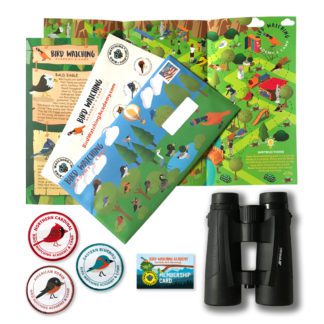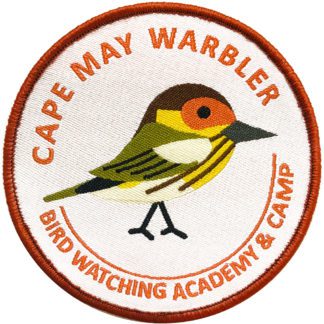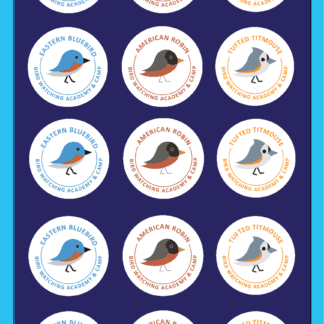
Warblers who go through the trouble of migration always live such interesting lives. The Cape May Warbler, more so than others. The summer is spent in the north in the spruce forests. Yet, come winter, they are seen in the Caribbean. Their diet in summer is restricted to insects, but they have no problem consuming nectars and fruits in winter. The stripes on their plumage shine brightly during spring, but you might not be easily able to recognize them with their drab plumage in fall.
Considering the varying habits of Cape May Warblers, it might be a good idea to read up on all you can about this bird species before you set out on your birding journey. After all, you want to experience the joy of knowing you got it right when you see them, don’t you?
There is also the joy of learning something new about a bird species if you are an avid bird watcher. In the case of Cape May Warbler, the information that they have a tubular tongue might be a point of wonder for you. After all, if you are acquainted with Warblers, you are aware that this is a unique trait belonging to Cape May Warbler. It will also help you realize it is these unique traits that help them consume more than insects. Because of this trait, they can change their diet to nectars and fruit juice during winter. It is why they can pierce fruits and flowers to get the juicy bits out in the first place.
Are these all not fascinating information to have? Well, we are certain you will enjoy learning even more about Cape May Warblers. We have some of the most vital information on Cape May Warblers for this purpose. Today you will learn:
- Cape May Warbler Photos, Color Pattern, Song
- Cape May Warbler Size, Eating behavior, Habitat
- Cape May Warbler Range and Migration, Nesting
GET KIDS BIRD WATCHING
Cape May Warblers Color Pattern
The upper portion of the adult male Cape May Warblers is an attractive olive color with a rich yellowish tint. The part right below their eyes and above it is a brown shade with yellow framing the rest of their cheeks and a little of the back of their heads. Just over their yellow belly and breasts are stripes of reddish-brown color, resembling the ones you see on a tiger. It is part of the reason Cape May Warblers are scientifically called Tigrina.
They also have yellow underparts along with a dense patch of white on the wings. The upper part of their wings is olive color overshadowed by black and brown stripes and patches. The top of their head is also a mix of brown, black and yellow.
The immature and female Cape May Warbler has much more yellow to show off on their body. It’s a more dull impression of the yellow on male Cape May Warblers, but the reddish-brown patch all over the body is missing. Instead, it’s gray patches, which are much more parse. The crown is also olive-gray, along with a cheek patch. The bill is gray-colored instead of the dark black color one comes to expect of the male of the species.
Description And Identification
There are plenty of ways to identify Cape May Warbler. Regrettably, despite the plethora of information available on the species, there still seems to be quite a lot missing because of how good they are at sneaking about and carrying on with their business when it comes to nesting.
Still, the songs and the color of their plumage are the easiest way to identify them. When it comes to the songs, one has only to hear the high-pitched sounds that never carry on for too long. While most warblers make high-pitched sounds, it is the lack of variation in pitches that make it easy to guess that one might be near a Cape May Warbler.
Then there is the matter of their plumage. For male Cape May Warbler, identifying them is easier than identifying female Cape May Warblers. This is mainly due to the tiger stripes over the otherwise yellow plumage and the reddish-brown surrounding the cheeks of the male Cape May Warbler. In comparison, female Cape May Warbler has a much duller shade of yellow along with gray stripes over their plumage that isn’t as prominent. They both have that splash of white on the underside of their tail, though. There is also a bit of the white splash present on the chest, in the case of both male and female Cape May Warbler.
Cape May Warbler Song
Male Cape May Warbler has thin 3-8 notes that are particularly high pitched, and they sound a lot like “tseet”. There isn’t much variation in the pitches. One might even confuse their song with that of Bay-Breasted Warbler. There is a secondary song that sounds quite similar, but the notes are doubled. Female Cape May Warbler hasn’t been reported to sing yet.
Among the calls, the most commonly heard one is a short “tsip” that’s as clear as it is high-pitched. The nocturnal Cape May Warblers also give a similar high pitches call which is their war cry. Other call types that have been reported include a” tsee” that starts off high and falls down when they are flying or in the middle of feeding. A “tzee” is heard when they are fighting or chasing another warbler down.
Cape May Warbler Size
The first thing that comes to mind when one sees a Cape May Warbler is that they are quite delicate looking. They have a small body and equally slender bill. They are about the size of a Sparrow. In fact, they are smaller than Song Sparrows but delightfully bigger compared to Ruby-Crowned Kinglets. In length, they range from 12 to 13 cm. Their weight appears to stick around the 10.2 to 15.2 g range. So, they can be quite fluffy or quite slender. Their wingspan is about 20 to 22 cm, which is just right for warblers.
Cape May Warbler Behavior
When they are on their breeding grounds, Cape May Warblers look for insects on source trees, mainly along the end of the branches. One can often see them hanging their heads to spot insects on the underside of the branches and pick them. They aren’t lazy about flying a few feet so they can grab insects that are in the middle of a flight. Since they enjoy nectars themselves during winter, they might try to defend flowers from other nectar consumers.
There haven’t been many reports on the courtship methods of Cape May Warblers. It is known that they are territorial and would go to lengths to chase the rival males away from their breeding ground. They also reportedly fly over the female Cape May Warblers with their wings held stiffly as an act of courtship.
What Cape May Warbler Eat
As is the case with most Warbler, Cape May Warbler eats insects like any other birds of their species. Insects will always be their first choice of food. In winter, though, they are willing to compromise and include some nectar of flowers and various juicy fruits into the mix. Their diet is concentrated around spruce budworms, beetles, moths, leafhoppers, bees, ants, and flies.
In winter, they are seen piercing the grapes so they can enjoy the juice. Sometimes, they drink the saps from the holes sapsuckers have left behind. It is only possible because of their tubular tongue, which is a unique feature among the warblers.
Where Cape May Warbler Live And Habitat
For breeding, spruce and balsam fir forest are their favorite. If there is an abundance of spruce budworms in the area, Cape May Warblers will be there for sure. During the migration period, there isn’t a wood forest or scrub they hesitate to show up in. Pine, forests, shrubs, Mangroves, as long as insects and flowers are there, they will show up.
Range and Migration

Like most Warblers, their chosen time of traveling is at night. From the Caribbean, they begin moving north, passing Florida on the way during springtime. Many of them move towards the south following the route of the Atlantic Coast during early fall time. Some of them linger even when fall is well over, and winter has reached the lands. It happens more so if they have already left their normal range.
Cape May Warbler Lifecycle
Cape May Warblers lay eggs in batches of 6 to 7. Sometimes, this number can get as low as 4 or big as 9. It has been noted that they are capable of laying a larger number of eggs when spruce budworm outbreaks happen. The eggs are white with spots of red and brown. It is unknown for how long these eggs need to be incubated. As the nests of Cape May Warblers are hidden, it is hard for researchers to observe and know the number of days it takes to incubate the eggs or who does the incubating. It is assumed it is mostly the female who takes over this part, though. Similarly, no one knows at which age the young are considered mature enough to leave the nest or feed the youngins.
Nesting
Male Cape May Warblers have the job of defending the territory they have designated for nesting from other warbler species, including Cape Mays. The courtship process involves a display done by the male where he flies above the female Cape May and has his wings expanded in a stiff manner.
They place it about 35’ to 60’ for the nest, usually on spruce or fir. They choose the trunk, mainly in areas where the foliage is particularly thick. A cup-shaped nest is made. Moss, weeds, vines make up most of the nest, with lining done with fur and feathers. It is assumed that it is the female Cape Mays who make the nest.
If you were to look for the nest, you probably wouldn’t come across it easily. Female Cape Mays warbler takes great pain to slip in and out of the nest. First, they fly extremely low to the tree and then use the trunks to enter their nest sneakily. Afterward, when she has to leave, she moves down the trunks and then flies away instead of leaving the nest directly as one would.
Anatomy of a Cape May Warbler
Cape May Warbler has a round but somewhat slender chest and stomach area. They are small birds with the bill somewhat decurved. Their eyes are pitch black and large for their face. They also have a particularly small faces. It must be noted that one can easily distinguish between the parts of their face and the chest area. They have thin, slender legs and claws that are equally thin. Their wings are big enough for warblers of their size, and the wings appear a bit flat when they are not expanded. Overall, Cape May Warblers make for an adorable sight.
Final Thoughts
The easiest way to come across Cape May Warbler is to lurk inside spruce forests. If there aren’t pure spruce forests around the area, you might find them in mixed forests with spruce and firs. During the migration period, deciduous and coniferous forests see a lot of these birds. As a birdwatcher, you might just strike gold during winter if you happen to be around the West Indies or in Florida. The palm trees seem to have incurred some favor from this species of bird.
Your chances of seeing Cape May Warblers have become bigger over the decades, in general. While their numbers have risen and fallen a lot over the years, with a marked increase every time there are more spruce budworms found in Northern Forests, the general consensus points towards the fact that they are stable for now. So, all the best in your endeavor in coming across one or showing an enthusiastic bird-watching child.
Bird Coloring Page
Cape May Warbler Bird coloring pages and coloring pictures have somewhat taken a back seat in the child’s development stage. Many children are becoming gadget-friendly and don’t like to do anything that involves something physical. Although cute coloring pages and coloring pictures might seem like a simple task, believe me, it has so many advantages. It excites children, and motivates them, and is a healthy educational activity. Here are some benefits of coloring pages for children.

Ornithology
Bird Watching Academy & Camp Subscription Boxes
At the Bird Watching Academy & Camp we help kids, youth, and adults get excited and involved in bird watching. We have several monthly subscription boxes that you can subscribe to. Our monthly subscription boxes help kids, youth, and adults learn about birds, bird watching, and bird conservation.
-
 Kids Bird Watching Monthly Subscription with 10×42 Binoculars$10.00 / month and a $58.00 sign-up fee
Kids Bird Watching Monthly Subscription with 10×42 Binoculars$10.00 / month and a $58.00 sign-up fee -
 12 Month Prepaid Bird Watching Subscription – 1 patch a month$84.00
12 Month Prepaid Bird Watching Subscription – 1 patch a month$84.00 -
 12 Month Prepaid Bird Watching Subscription – 3 patches a month$120.00
12 Month Prepaid Bird Watching Subscription – 3 patches a month$120.00
Bird Watching Binoculars for Identifying Cape May Warbler
The most common types of bird-watching binoculars for viewing Cape May Warblers are 8×21 binoculars and 10×42 binoculars. Bird Watching Academy & Camp sells really nice 8×21 binoculars and 10×42 binoculars. You can view and purchase them here.
-
 Birding Binoculars$49.99
Birding Binoculars$49.99 -
 Kids Binoculars$13.99
Kids Binoculars$13.99
Cape May Warbler Iron On Patches
Kids, Youth, and Adults love to collect our Bird Watching Academy & Camp iron-on patches. Our bird-watching patches help you keep track of the birds you have seen and identified. You can also display the patches on our Bird Watching Academy & Camp banners.
The Cape May Warbler is a great iron-on patch to start your collection with. The patches are durable and can be sewn on or ironed on to just about anything.
-
 Cape May Warbler Iron on Patch$2.99
Cape May Warbler Iron on Patch$2.99 -
 Bird Banner$10.99
Bird Banner$10.99
Cape May Warbler Stickers
Stickers are a great way for you to display your love for bird watching and the Cape May Warbler. Here is the sticker pack we sell with a Cape May Warbler sticker.
Bird Feeders For Cape May Warbler
There are many types of bird feeders. Bird feeders are a great addition to your backyard. Bird feeders will increase the chances of attracting birds drastically. Both kids and adults will have a great time watching birds eat at these bird feeders. There are a wide variety of bird feeders on the market and it is important to find the best fit for you and your backyard.
Best Bird Houses For Cape May Warbler
There are many types of birdhouses. Building a birdhouse is always fun but can be frustrating. These 4 birdhouses have become our favorites. Getting a birdhouse for kids to watch birds grow is always fun. We spent a little extra money on these birdhouses but they have been worth the higher price and look great.





